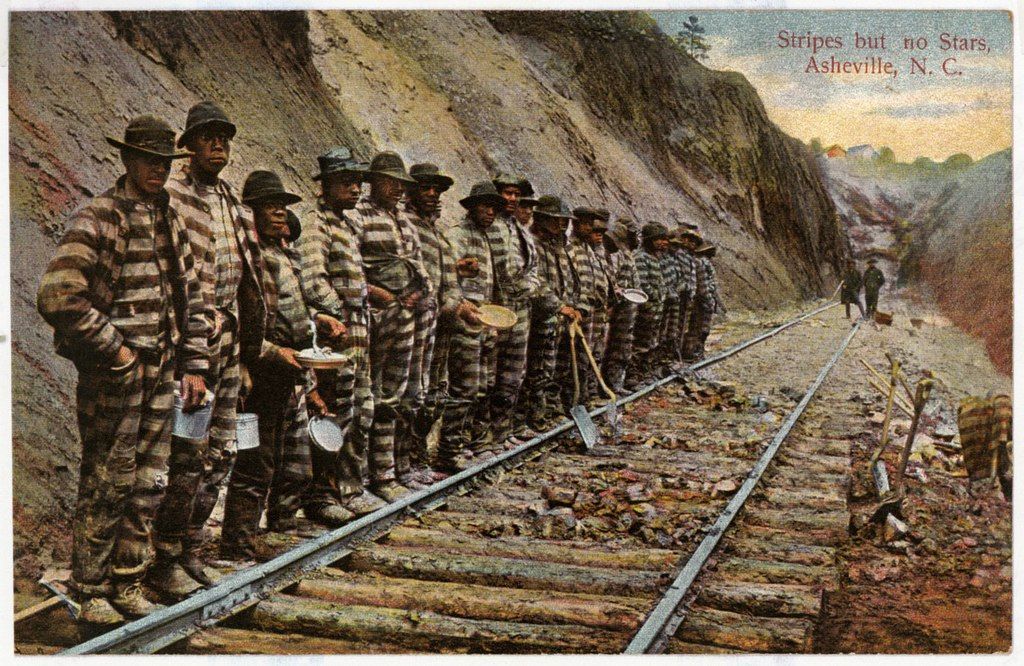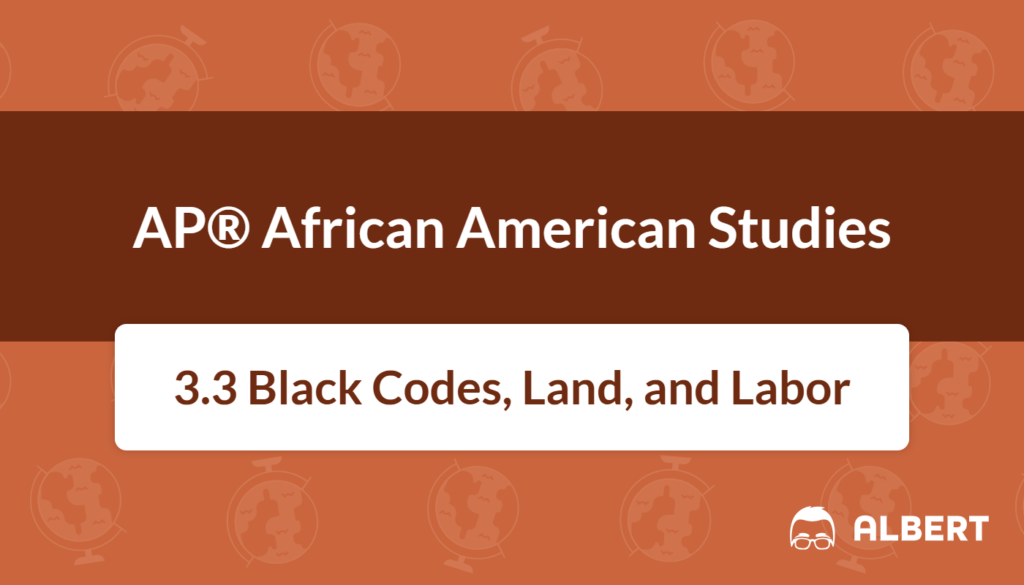What We Review
3.3 Black Codes, Land, and Labor: Understanding the Struggles of African Americans Post-Abolition
Introduction
After the Civil War ended in 1865, many Americans believed that the formal abolition of slavery would set African Americans on a new path toward freedom and opportunity. However, progress was not straightforward. States in the South soon passed “Black Codes” that aimed to keep African Americans under tight control. These laws restricted their legal rights, movement, and ability to earn a fair wage. Understanding the Black Codes and related labor practices is important to see how African Americans’ fight for genuine freedom continued, even after slavery’s official end.
Below is an overview of the Black Codes, the new labor practices that emerged, and how these factors shaped the social and economic realities of African Americans during the Reconstruction era.
What Are the Black Codes?
Black Codes were laws passed mainly in Southern states in 1865 and 1866. During this period, known as Presidential Reconstruction, these laws replaced older “slave codes” and served a similar purpose: to keep African Americans under control. Although freedom was now guaranteed in theory, Black Codes limited freedoms in practice.
- Black Codes often made it illegal for African Americans to testify against white people.
- Some states required African Americans to have labor contracts or else face imprisonment.
- Other regulations barred them from owning certain types of property.
Restrictions on Movement and Labor
The Black Codes often targeted African Americans’ ability to move freely or seek their own work. Many laws stated that any person without proof of steady employment could be arrested for vagrancy.
- African Americans were required to sign annual labor contracts with white employers.
- If a worker escaped a harsh contract, local law enforcement could whip them or force them back to work.
- Anyone without a valid contract risked fines or further punishment.
Impact on Families
Black Codes not only limited job options; they also tore apart families. In some places, children of African American families were taken and forced into unpaid apprenticeships.
- These apprenticeships:
- Did not require parental consent.
- Gave white guardians control over a child’s labor and upbringing.
- Often existed in harsh conditions similar to earlier forms of servitude.
New Labor Practices
Special Field Orders No. 15
In 1865, General William T. Sherman issued Special Field Order 15, which set aside about 400,000 acres of land for newly freed African American families. Each family was promised a plot of about 40 acres.
- This order sparked hope that families could build their own farms.
- It was the first plan that offered actual land distribution to former enslaved people.
Revocation of Special Field Orders
Unfortunately, President Andrew Johnson revoked Special Field Order 15. This decision meant that the land given to freed families would be returned to its former owners or sold to investors.
- Thousands of African Americans were forced off the properties they had begun to develop.
- Many ended up seeking work as tenant farmers or sharecroppers because they no longer had land.
Example: Before and After
Before the revocation, a community might be working together to build schools and shared farming practices. After the revocation, many were suddenly homeless again, returning to a life of dependency under landowners who set unfair terms.
Sharecropping
What is a sharecropper? A sharecropper is someone who farms land owned by another person in exchange for a portion of the harvest instead of a fixed salary. After Special Field Order 15 was revoked, sharecropping became a common system.
- Landowners provided land and tools.
- Freed people worked the land.
- At harvest, the landowner received a large share of the crops as payment.
Because the sharecropper rarely got to keep enough profit, it was very hard to accumulate savings and move up the economic ladder.
A Typical Sharecropping Contract
- The sharecropper agrees to plant and harvest cotton.
- The landowner provides seeds, a mule, and basic tools.
- At harvest, the sharecropper must give the landowner half of the cotton.
- Fees for seeds, equipment, and living supplies reduce the sharecropper’s final earnings.
In this system, sharecroppers often ended up in cycles of debt.
The Crop Lien System
The crop lien system was another practice that trapped farmers—both Black and white—in continuous debt. A crop lien is a loan taken against the future harvest. When the harvest came, the borrower had to repay the loan plus interest.
- If the harvest was poor or crop prices fell, farmers might owe more than they earned.
- Debt would roll over into the next year, making it almost impossible to escape.
A Debt Trap
- A farmer borrows money to buy seeds and supplies.
- The harvest yields fewer crops than expected.
- Profits do not cover the loan repayment.
- The debt is carried into next season, and the farmer must borrow more.
Over time, many African American farmers found it nearly impossible to break free from this economic cycle.
Convict Leasing System
The “convict leasing system” occurred when prisons leased out inmates—often African American men—to private companies. This practice was not much different from slavery.
- Prisoners received no pay.
- Corporations profited greatly from cheap labor.
- Many arrests were based on debts or minor infractions, targeting African Americans disproportionately.
Example: A Prisoner’s Experience
Imagine an individual arrested for “vagrancy.” A judge might sentence him to jail, and then the prison would lease him out to a nearby plantation or railroad company. He would work long hours with little food or care. This arrangement gave local governments and businesses strong incentives to keep convict labor going, reinforcing a system that closely resembled slavery.

Conclusion
Together, the Black Codes and new labor practices—such as sharecropping, the crop lien system, and convict leasing—created an environment that undermined African Americans’ ability to achieve true economic freedom. Even though slavery had been declared illegal, these systems ensured that many former enslaved people remained in conditions that were oppressive and exploitative. This period set the stage for ongoing struggles in civil rights, education, and economic equality.
Connections to Key Historical Sources
- Land Order for Richard Brown, 1865
- This document shows how individuals received land under Special Field Order 15. It highlights the promise of real economic freedom and the potential for families to own and farm their own property.
- Juvenile Convicts at Work in the Fields, 1903
- This image underscores how convict leasing extended to children. It provides a stark reminder that forced labor practices often continued well into the 1900s, targeting even the most vulnerable populations.
- Circular No. 8 from the Bureau of Refugees, Freedmen, and Abandoned Lands, 1866
- This communication demonstrates how official policies frequently influenced the formation of labor contracts for freed people. While intended to aid African Americans, the Freedmen’s Bureau had limited power and sometimes reinforced existing social dynamics.
- Picture Postcard of a North Carolina Convict Camp, Circa 1910
- This postcard provides a glimpse into how everyday life in a convict camp might have looked. It also reveals the social acceptance of a system that closely mirrored slavery, showcasing groups of prisoners leased out to perform tough labor.
These sources connect directly to the Black Codes and labor systems discussed above. They show how legal documents and visual evidence together illustrate the challenges African Americans faced during Reconstruction and beyond.
Quick Reference Chart of Key Terms
| Term | Definition |
| Black Codes | Laws passed after the Civil War to limit African Americans’ rights and freedoms, controlling movement and labor. |
| Sharecropper | A farmer who works someone else’s land in exchange for a share of the crops, rather than a fixed wage. |
| Crop Lien | A system where farmers borrow against their future harvests to buy supplies, often resulting in long-term debt. |
| Special Field Orders No. 15 | Orders (later revoked) that aimed to redistribute land to freed families in parcels of about 40 acres. |
| Convict Leasing System | A practice where prisons rented out prisoners, mostly African American men, to private companies for forced labor. |
Sharpen Your Skills for AP® African American Studies
Are you preparing for the AP® African American Studies test? We’ve got you covered! Try our review articles designed to help you confidently tackle real-world AP® African American Studies problems. You’ll find everything you need to succeed, from quick tips to detailed strategies. Start exploring now!
Need help preparing for your AP® African American Studies exam?
Albert has hundreds of AP® African American Studies practice questions, free response, and full-length practice tests to try out.









